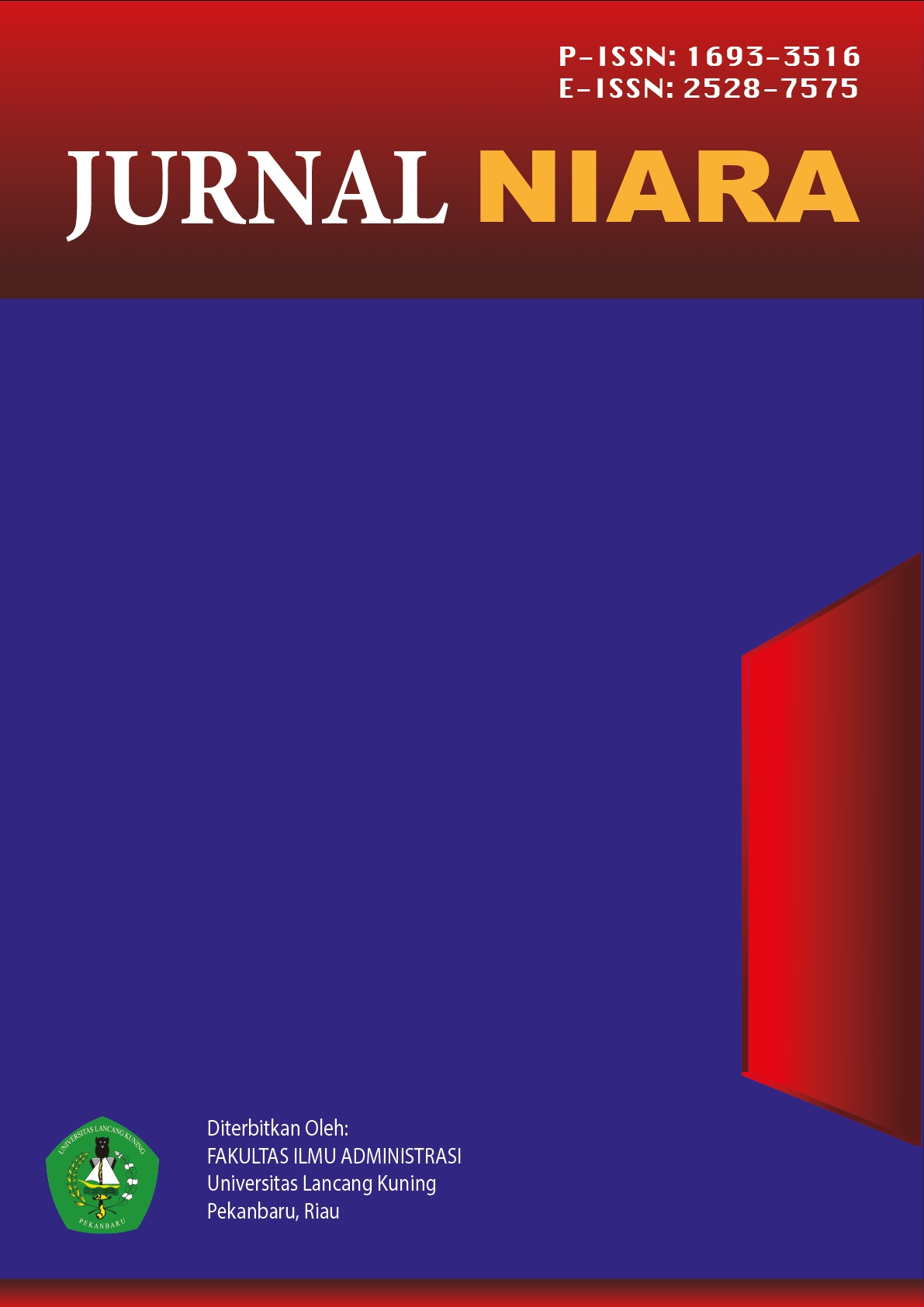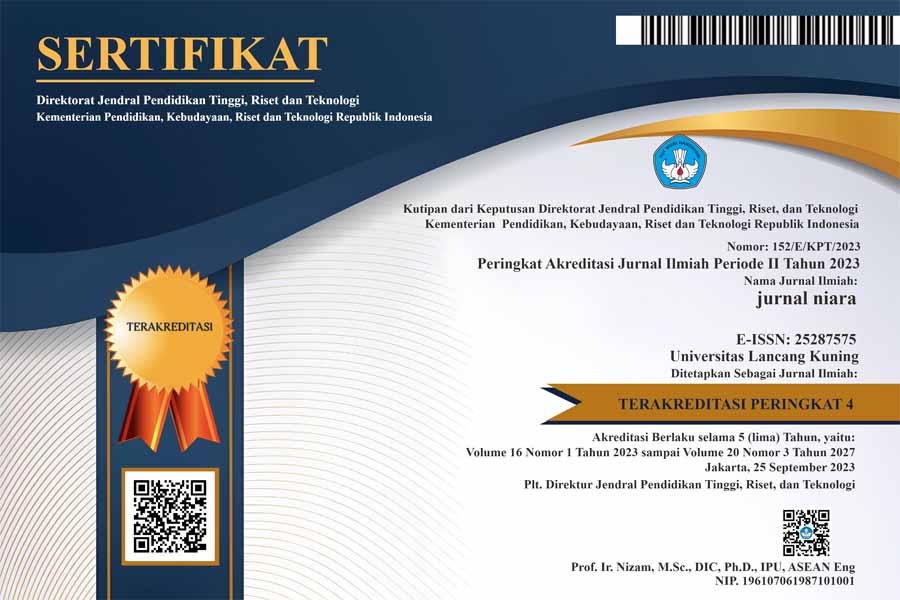Can the attitude of implementing an occupational safety and health program improve employee work discipline?
Abstract
This research aims to determine the relationship between attitudes towards implementing occupational safety and health programs and employee work discipline. This research used as subjects 57 employees of PT. PLN (Persero) Pekanbaru branch, research data was collected using two scales, namely the attitude scale for implementing occupational safety and health programs compiled by the researcher himself with a total of 30 items and the employee work discipline scale used was compiled by the researcher himself based on disciplinary theory with a total of 28 items. Sampling in this research used the summated ratings method, data analysis using product moment analysis, with the help of the SPSS 24.0 for Windows computer program. Based on the results of the analysis, it was found that there was a positive relationship between the attitude towards implementing occupational safety and health programs and employee work discipline, the correlation coefficient was 0.738 with p = 0.000, so the hypothesis was accepted, meaning that the higher the attitude towards implementing occupational safety and health programs, the greater the contribution to improve employee work discipline
Downloads
References
Arikunto, S. (2006). Prosedur penelitian suatu pendekatan praktik. Jakarta : Rineka Cipta.
As’ad. M. (2003) Psikologi industri, Yogyakarta:PT. Liberty.
Azwar,S. (2003). Penyusunan skala psikologi. Yogyakarta : Pustaka Pelajar.
Danggur, K. (2006). Keselamatan kesehatan kerja. Jakarta : Litbang Danggur and Patners
Husni, L. (2000). Pengantar hukum ketenagakerjaan indonesia. Jakarta : PT. Raja Grafindo Persada.
Nurmansyah, S.R. (2010). Manajemen sdm srategi. Pekanbaru: Unilak Press
Wati, F. I., Zaki, H., & Akhmad, I. (2021). Pengaruh Penerapan Disiplin Kerja Dan Keselamatan Kesehatan Kerja (K3) Terhadap Produktivitas Kerja Karyawan PT. Kelapa Sawit Sewangi Sejati Luhur Kabupaten Kampar. ECOUNTBIS: Economics, Accounting and Business Journal, 1(1), 343-352.
Sudwiyatmoko, M., Rodhiyah, R., & Nurseto, S. (2014). Pengaruh disiplin kerja, keselamatan dan kesehatan kerja, serta lingkungan kerja terhadap produktivitas karyawan bagian produksi PT. Barlow Tyrie Indonesia. Jurnal Ilmu Administrasi Bisnis, 3(4), 122-131.
Anggreini, O. S., Nugraha, H. S., & Dewi, R. S. (2014). Pengaruh Keselamatan dan Kesehatan Kerja (K3) Dan Disiplin Kerja Terhadap Produktivitas Kerja Pada Karyawan Bagian ProduksiPT. Pura Barutama Unit Paper Mill Kudus. Jurnal Ilmu Administrasi Bisnis, 3(4), 394-399.
Pangestu, A. (2016). Pengaruh Program Keselamatan dan Kesehatan Kerja (K3) dan Disiplin Kerja Karyawan Terhadap Produktivitas Kerja Karyawan (Studi Kasus Pada PT Wika Realty Proyek Pembangunan Tamansari Hive Office Park) (Bachelor's thesis, Jakarta: Fakultas Ekonomi dan Bisnis UIN Syarif Hidayatullah Jakarta).
Ariko, M. F. (2019). Pengaruh Disiplin Kerja, Kompetensi, Serta Keselamatan Dan Kesehatan Kerja Terhadap Kinerja Karyawan PT. Sucofindo (Persero) Cabang Palembang. Jurnal Ilmu Manajemen, 8(1), 73-84.
Elenika, M., & Putra, A. (2021). Pengaruh Disiplin Kerja, Kepuasan Kerja Dan Program Keselamatan Dan Kesehatan Kerja (K3) Terhadap Produktivitas Kerjakaryawan Pt. Sumber Usaha Kencana Agung Kabupaten Asahan. Jurnal Sains Ekonomi (JSE), 2(2), 49-56.
Barza, P., & Arianti, J. (2019). Pengaruh Kecerdasan Emosional, Disiplin Kerja Dan Keselamatan Serta Kesehatan Kerja (K3) Terhadap Organizational Citizenship Behavior (Ocb) Pada Pramudi Bus Transmetro Pekanbaru. Procuratio: Jurnal Ilmiah Manajemen, 7(4), 496-508.
Rohimah, A. (2019). pengaruh keselamatan dan kesehatan kerja (k3) serta disiplin kerja terhadap produktivitas kerja karyawan di pgt (pabrik gondorukem dan terpentyn) sukun, pulung ponorogo (Doctoral dissertation, IAIN PONOROGO).
McCullagh, M. C., Valentín-Cortés, M. A., D'Souza, C., Batterman, S. A., Neitzel, R., Zhen, H., & O'Neill, M. S. (2022). Integrating interprofessional collaborative practice into occupational and environmental health and safety education: Results of a feasibility study. Journal of occupational and environmental medicine, 64(8), 653-658.
Hanson, E., & Boland, M. (2020). Safety climate at agricultural cooperatives. Journal of safety research, 75, 150-154.
Mucci, N., Giorgi, G., Gonnelli, I. M., Garbarino, S., Cupelli, V., & Arcangelil, G. (2016). The operational role of the occupational health physician in the assessment and management of health risks related to night risks. Giornale italiano di medicina del lavoro ed ergonomia, 38(1), 22-29.
Bentley, T., & Tappin, D. (2010). Incorporating organisational safety culture within ergonomics practice. Ergonomics, 53(10), 1167-1174.
Bohnke, E., Beer, B., Heckmann, G., von Rosenstiel, L., & Nowak, D. (2005). An attempt to include key qualifications in the education of occupational physicians-basis of a concept for further education at the Bavarian academy for occupational, social and environmental medicine. ARBEITSMEDIZIN SOZIALMEDIZIN UMWELTMEDIZIN, 40(8), 442.
Foley, M. E., Keepnews, D., & Worthington, K. (2001). Identifying and using tools for reducing risks to patients and health care workers: A nursing perspective. The Joint Commission Journal on Quality Improvement, 27(9), 494-499















